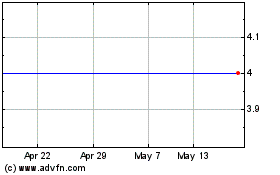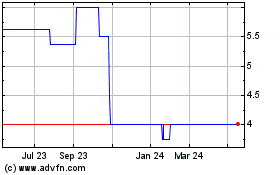Aisi Realty Public Limited Half Yearly Report -10-
September 05 2012 - 2:00AM
UK Regulatory
of market value. All the payments are projected in nominal US
dollar amounts and thus incorporate relevant inflation measures.
Valuation Approach
In addition to the above general valuation methodology, the appraisers
have taken into account in arriving at Market Value the following:
Pre Development
In those instances where the nature of the 'Project' has been
defined, it was assumed that the subject property will be developed
in accordance with this blueprint. The final outcome of the development
of the property is determined by the Board of Directors decision,
which is based on existing market conditions, profitability of
the project, ability to finance the project and obtaining required
construction permits.
Development
In terms of construction costs, the budgeted costs have been
taken into account in considering opinions of value. However,
the appraisers have also had regard to current construction rates
passing in the market which a prospective purchaser may deem
appropriate to adopt in constructing each individual scheme.
Although in some instances the appraisers have adopted the budgeted
costs provided, in some cases the appraisers' own opinions of
costs were used.
Post Development
Rental values have been assessed as at the date of valuation
but having regard to the existing occupational markets taking
into account the likely supply and demand dynamics during the
anticipated development period. The standard letting fees were
assumed within the valuations. In arriving at their estimates
of gross development value ("GDV"), the appraisers have capitalized
their opinion of net operating income, having deducted any anticipated
non-recoverable expenses, such as land payments, and permanent
void allowance, which has then been capitalized into perpetuity.
The capitalization rates adopted in arriving at the opinions
of GDV reflect the appraisers' opinions of the rates at which
the properties could be sold as at the date of valuation.
In terms of residential developments, the sales prices per sq.
m. again reflect current market conditions and represent those
levels the appraisers consider to be achievable at present. It
was assumed that there are no irrecoverable operating expenses
and that all costs will be recovered from the occupiers/owners
by way of a service charge.
The valuations take into account the requirement to pay ground
rental payments and these are assumed not to be recoverable from
the occupiers. In terms of ground rent payments, the appraisers
have assessed these on the basis of information available, and
if not available they have calculated these payments based on
current legislation defining the basis of these assessments.
Property tax is not presently payable in Ukraine.
3.18 Non--current liabilities
Non--current liabilities represent amounts that are due in more
than twelve months from the reporting date.
3.19 Project/Special Purpose Vehicle Related Transaction Expenses
Expenses incurred by the Group for acquiring a subsidiary or
associated company and are directly attributable to such acquisition
are recognized in the statement of comprehensive income.
3.20 Provisions
Provisions are recognized when the Group has a present obligation
(legal or constructive) as a result of a past event, it is probable
that the Group will be required to settle the obligation and
a reliable estimate can be made of the amount of the obligation.
The amount recognized as a provision is the best estimate of
the consideration required to settle the present obligation at
the end of the reporting period, taking into account the risks
and uncertainties surrounding the obligation. When a provision
is measured using the cash flows estimated to settle the present
obligation, its carrying amount is the present value of those
cash flows (where the effect of the time value of money is material).
When some or all of the economic benefits required to settle
a provision are expected to be recovered from a third party,
a receivable is recognized as an asset if it is virtually certain
that reimbursement will be received and the amount of the receivable
can be measured reliably.
3.21 Financial liabilities and equity instruments
3.21.1 Classification as debt or equity
Debt and equity instruments issued by a Group entity are classified
as either financial liabilities or as equity in accordance with
the substance of the contractual arrangements and the definitions
of a financial liability and an equity instrument.
3.21.2 Equity instruments
An equity instrument is any contract that evidences a residual
interest in the assets of an entity after deducting all of its
liabilities. Equity instruments issued by the Group are recognized
at the proceeds received, net of direct issue costs. Ordinary
shares are classified as equity. The difference between the fair
value of the consideration received by the Company and the nominal
value of the share capital being issued is taken to the share
premium account
Repurchase of the Company's own equity instruments is recognized
and deducted directly in equity. No gain or loss is recognized
in the statement of comprehensive income on the purchase, sale,
issue or cancellation of the Company's own equity instruments.
3.21.3 Financial liabilities
Financial liabilities are classified as either financial liabilities
"at FVTPL" or "other financial liabilities".
3.21.3.1 Financial liabilities at FVTPL
Financial liabilities are classified as at FVTPL when the financial
liability is either held for trading or it is designated as at
FVTPL.
A financial liability is classified as held for trading if:
* it has been acquired principally for the purpose of
repurchasing it in the near term; or
* on initial recognition it is part of a portfolio of
identified financial instruments that the Group
manages together and has a recent actual pattern of
short-term profit-taking; or
* it is a derivative that is not designated and
effective as a hedging instrument.
A financial liability other than a financial liability held for
trading may be designated as at FVTPL upon initial recognition
if:
* such designation eliminates or significantly reduces
a measurement or recognition inconsistency that would
otherwise arise; or
* the financial liability forms part of a group of
financial assets or financial liabilities or both,
which is managed and its performance is evaluated on
a fair value basis, in accordance with the Group's
documented risk management or investment strategy,
and information about the grouping is provided
internally on that basis; or
* it forms part of a contract containing one or more
embedded derivatives, and IAS 39 Financial
Instruments: Recognition and Measurement permits the
entire combined contract (asset or liability) to be
designated as at FVTPL.
Financial liabilities at FVTPL are stated at fair value, with
any gains or losses arising on remeasurement recognized in profit
or loss. The net gain or loss recognized in profit or loss incorporates
any interest paid on the financial liability and is included
in the "other gains and losses" line item in the consolidated
statement of comprehensive income. Fair value is determined in
the manner described in section 2.20.8.
3.21.3.2 Other financial liabilities
Other financial liabilities (including borrowings) are subsequently
measured at amortised cost using the effective interest method.
The effective interest method is a method of calculating the
amortised cost of a financial liability and of allocating interest
expense over the relevant period. The effective interest rate
is the rate that exactly discounts estimated future cash payments
(including all fees and points paid or received that form an
integral part of the effective interest rate, transaction costs
and other premiums or discounts) through the expected life of
the financial liability, or (where appropriate) a shorter period,
to the net carrying amount on initial recognition.
3.21.3.3 De-recognition of financial liabilities
The Group derecognises financial liabilities when, and only when,
the Group's obligations are discharged, cancelled or they expire.
The difference between the carrying amount of the financial liability
derecognized and the consideration paid and payable is recognized
in profit or loss.
3.22 Value added tax
VAT is levied at the following rates:
* 20% on Ukrainian domestic sales and imports of goods,
works and services and 0% on export of goods and
provision of works or services to be used outside
Ukraine.
* 17% on Cyprus domestic sales and imports of goods,
works and services and 0% on export of goods and
provision of works or services to be used outside
Cyprus.
A taxpayer's VAT liability equals the total amount of VAT collected
within a reporting period, and arises on the earlier of the date
of shipping goods to a customer or the date of receiving payment
from the customer. A VAT credit is the amount that a taxpayer
is entitled to offset against his VAT liability in a reporting
period. Rights to VAT credit arise on the earlier of the date
of payment to the supplier or the date goods are received. The
part of VAT credit expected to be recovered in the long-term
prospective is classified as non-current being discounted for
reflecting principal market assumptions as to projects realization.
Initial loss on discounting VAT credit, non-current was recognized
as part of finance costs.
3.23 Offsetting financial instruments
Financial assets and financial liabilities are offset and the
net amount reported in the consolidated statement of financial
Secure Property Developm... (LSE:SPDI)
Historical Stock Chart
From Jul 2024 to Aug 2024

Secure Property Developm... (LSE:SPDI)
Historical Stock Chart
From Aug 2023 to Aug 2024
